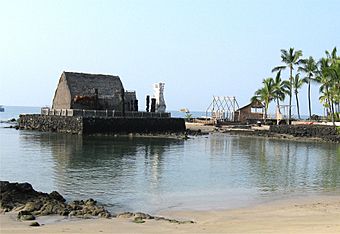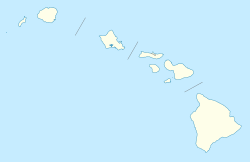Kamakahonu facts for kids
|
Kamakahonu, Residence Of King Kamehameha I
|
|

ʻAhuʻena Heiau
|
|
| Location | 75-5660 Palani Road, Kailua-Kona, Hawaii |
|---|---|
| Area | 3.5 acres (1.4 ha) |
| Built | 1812 |
| NRHP reference No. | 66000288 |
Quick facts for kids Significant dates |
|
| Added to NRHP | October 15, 1966 |
| Designated NHL | December 29, 1962 |
Kamakahonu was a special home for Kamehameha I, a famous Hawaiian king. It was located at the northern end of Kailua Bay in Kailua-Kona, on the Big Island of Hawaiʻi. This place was very important in Hawaiian history.
Contents
A King's Home: Kamakahonu
Kamakahonu was the last home of Kamehameha I, also known as Kamehameha the Great. He was the king who united all the Hawaiian Islands. He lived here from 1810 until he passed away in 1819.
During his time at Kamakahonu, King Kamehameha made many important decisions for his kingdom. His home included a special temple called ʻAhuʻena heiau. A heiau is a Hawaiian temple or place of worship. The name ʻAhuʻena means "temple of the burning altar" in the Hawaiian language.
Royal Family and Battles
King Kamehameha's son, Liholiho, also lived at Kamakahonu. Liholiho later became King Kamehameha II.
In December 1819, a leader named Kalanimoku gathered an army from Kamakahonu. They went to stop a rebellion led by his nephew, Kekuaokalani. This battle, called the Kuamoʻo Battle, happened a few miles south of Kamakahonu.
The king's home was like a strong fort. It had large stone walls and 18 cannons to protect it.
Governors and New Buildings
Later, the island's governor, "John Adams" Kuakini, lived at Kamakahonu. He was in charge of the island when the king was away. He also governed after the capital moved to Lahaina on the island of Maui in 1820.
Governor Kuakini later built a new house called Huliheʻe Palace. It was on the other side of the beach. This palace was built in a Western style and used for entertaining important visitors.
The Bay and Its Name
In ancient times, Kailua Bay was called Kaiakeakua. This means "sea of the god." Today, it is known as Kailua Bay.
The name ka maka honu means "the turtle eye" in Hawaiian. This name came from a rock shaped like a turtle. This rock was located to the left of the beach that is there today.
Arrival of Missionaries
Kamakahonu is also famous because the first American Christian missionaries arrived here. They came to Hawaiʻi on April 4, 1820. This was less than a year after King Kamehameha passed away.
The rock where missionaries Asa Thurston and Hiram Bingham I landed became known as the "Plymouth Rock of Hawaii."
Kamakahonu Today
The northern point of Kamakahonu was once called Kūkaʻilimoku. This name means Kū, the thief of the islands. It was named after the war god Kū, whom King Kamehameha I honored. Today, the Kailua lighthouse stands on this point.
The Hotel and Reconstructions
The land where Kamakahonu once stood is now part of King Kamehameha's Kona Beach Hotel. The original houses and walls are no longer there.
However, the ʻAhuʻena heiau (temple) was rebuilt in the 1970s. You can see it, but you cannot go inside. Some old Hawaiian items, like a feather cloak and a helmet (called a mahiole), are on display in the hotel lobby.
The small sandy beach at Kamakahonu is a safe place for launching canoes. It's also a great spot for children to swim. The first hotel building was built here in 1960. A new building replaced it in 1974. In 2009, the hotel was updated, and a museum and cultural center were added. The hotel is now run by Courtyard Marriott.
Changes to the Area
The famous "turtle eye" rock was covered when the pier was built. Much of the beach was also changed in the 1950s to build a seawall for Aliʻi Drive.
Cattle pens were used on the pier until 1966. When a deeper harbor was built at Kawaihae, large cargo ships started going there instead.
This area is also well-known as the starting and finishing point for the Ironman World Championship Triathlon.
Gallery
See also
 In Spanish: Kamakahonu para niños
In Spanish: Kamakahonu para niños







